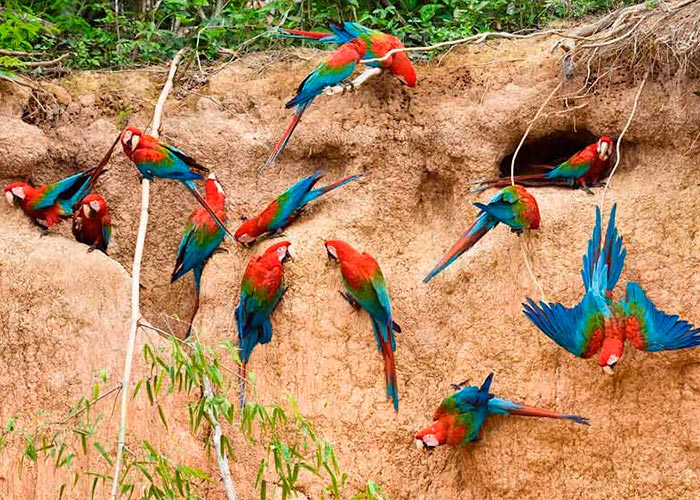DAY 1:
Departure from Cusco very early in the morning in one of our vehicles. We will cross interesting Andean valleys and picturesque peasant communities visiting the Tombs Pre-Inca "Chullpas" Ninamarca. A half day pass by Paucartambo typical colonial town of great importance at that time and still retains its colonial style. Continuing the journey to ascend to the Acjanacu at 3,850 m. from here we will descend through the cloud forest, an area rich in endemic species as the spectacled bear, cock of the rock, orchids, bromeliads, ferns, etc. Lunch on the way observing the nature and then continue to reach our hostel Orchids San Pedro where we spend our first night comfortably installed.
Day 2:
Very early we appreciate the interesting courtship dance of the Cock of the Rock, Peru's national bird, who has a striking plumage of red-orange intense, comfortably installed on an observation platform called "Lek" After. breakfast we continue in our bus, crossing the high forest, arriving at Pilcopata * and then continue to the port of Atalaya (600 meters), where we have lunch, this place is situated on the Alto Madre de Dios river, where we expect our boat with outboard, board the boat that is loaded with the necessary equipment for the trip, thus beginning our descent down the river where we can see the huge variety of birds such as herons, vultures, cormorants, etc. to reach our "Erika" Private Reserve where we spend the next 2 nights. Short recognition walk around.
1 Free Optional: From the town of Pilcopata travel approx. 3 hours rafting (class II and III) by tropical rivers Kosñipata and Alto Madre de Dios, past the spectacular Pongo de Koñeq where we stop to enjoy the scenery and a swim in its waters. It will continue until we reach our "Erika" Private Reserve.
Day 3:
Erika is located in a transition zone between High Forest and Low Forest (500 m - 1,550 m) After breakfast the guide will explain the different altitudes give rise to different habitats and the high diversity of wildlife in the surroundings. After lunch, we board our boat to sail for 5 minutes to cross the Madre de Dios River and walk for about 30 minutes along an interesting path to observe and discuss interesting flora as the sensitive plants, heliconias, fruit plantations, etc. . to reach the lagoon where Machuwasi install the telescope to observe birds like herons, toucans, crestirojo carpenter, bienteveos, cardinal, etc.
Day 4:
We start early morning and take a short hike to see some animals, after breakfast we will have time to perform some activities this agreement passengers and guides, will also have some free time. Early afternoon devote our time to walk in search of wildlife in this Jungle: Possibility of a short night walk.
2 Optional: Restaurants Canopy tour: Our customers go from tree to tree and platform to platform using a horizontal cable harnesses with a rail system with sliding at high speed over the treetops of this fabulous Amazon jungle where you can see from the high diversity and other birds in the area. Expert guides assist you at all times during this exciting experience and explain everything interesting to observe from the moment you leave the ground until rappel down from 30 meters high.
Day 5:
Very early we will board our boat to sail for 10 minutes to go to the Collpa, a clay wall of the river where different species of parrots like the blue head, white eyed parakeets and possibly Maracano macaw (Ara severa ) among others, go every morning to extract and lick clay pieces that contain necessary minerals for their diet. At the end of this daily activity return to Erika Lodge After breakfast we take the boat to the port of Atalaya, where we expect the bus to take us back to Cusco, we will lunch in route arriving at night.
End of our service
MANU NATIONAL PARK
One of the largest tropical parks in South America. Located in the Southeast region of Peru, located in the last Andean foothills of the department of Cusco, and Madre de Dios jungle. It covers an area of 2 million square hectares of territory rich in flora and fauna with a variety of habitats Andean high Andean, tropical and subtropical.
This natural paradise recognized by UNESCO as a World Biosphere Reserve; It houses the largest biodiversity in protected areas of rainforest and several endemic species of the cloud forest.Given that many of these forests around the globe are being impacted by human actions, we are fortunate to have an almost intact Manu, untouched by civilization, where we can still observe in the wild species in imminent danger species such as the giant river otter (Pteronura brasiliensis), Black Caiman (Melanosuchus niger), the majestic Jaguar (Panthera onca), the strange Spectacled Bear (Tremarctos ornatus), and other animals like Tapir, Ocelot, thirteen species primate, and more than a thousand species of birds, including 7 species of macaws (Ara sp.)
To this we should add that this reserve is home to 10% of the world's plant species including trees, powdery and countless species of medicinal plants that are just being cataloged and placed at the service of science wood. In one hectare of forest in Manu can have up to 220 species of trees, while one the same size in Europe or the United States, there are only 20.Without a mistake Manu National Park is probably the richest protected area on biodiversity of the entire planet.

